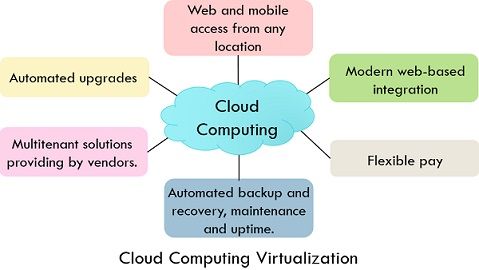 Cloud computing and virtualization are very closely related terms where the virtualization drives single resource behaves as many whereas cloud computing enables distinct departments and companies retrieve a single pool of spontaneously provisioned resources. Virtualization is the primary technology used to make the cloud computing functional. However, it is different from cloud computing which we have described below in detail.
Cloud computing and virtualization are very closely related terms where the virtualization drives single resource behaves as many whereas cloud computing enables distinct departments and companies retrieve a single pool of spontaneously provisioned resources. Virtualization is the primary technology used to make the cloud computing functional. However, it is different from cloud computing which we have described below in detail.
Content: Cloud Computing Vs Virtualization
Comparison Chart
| Basis for comparison | Cloud Computing | Virtualization |
|---|---|---|
| Basic | Pool and automate virtual resources for on-demand use. | Built multiple simulated environments from one physical hardware system. |
| Scalability | High | Low |
| Set-up | Tedious | Simple |
| Cost | Private cloud: High CAPEX and low OPEX Public cloud: Low CAPEX and high OPEX | High capital expenditures (CAPEX), low operating expenses (OPEX). |
| Flexibility | Very flexible | Quite less |
| Type of service | Iaas | Saas |
| Dedicated hardware | Multiple | Single can also work |
| Integration | Future expansion of users, application, etc. | Expansion of new machines within the same infrastructure. |
| Workload | Stateless | Stateful |
| Disaster recovery | Depends on multiple machines | Depends on a single machine |
| Form | Private and public cloud | Hardware and application virtualization |
| Accessibility | Prevalently accessed | Not allowed to be accessed from outside the network |
Definition of Cloud Computing
Cloud computing refers to a set of principles and approaches to deliver the application and services that run on a distributed network and accessed by general internet protocol on demand. It can provide limitless virtual computing, network, storage and infrastructure resources, services, platforms and applications.
In a simpler way, Cloud computing comprised of the technology, services and applications that can be delivered over the internet and turns them into a self-service utility.
The term cloud is relevant to the two fundamental concepts. One of which is an abstraction and the second one is virtualization.
- Abstraction: Cloud computing hides the details of the system implementation from the end users and developers. Applications runs on the undefined physical systems. Similarly, data is stored at undetermined locations. The systems administration is outsourced to others and accessed by the user globally.
- Virtualization: virtualization plays an essential function in cloud computing by pooling and sharing resources. It can provide the system and storage as required from centralized infrastructure, charges are imposed on a metered basis, multitenancy is employed, and resources can be swiftly scaled.
Definition of Virtualization
Virtualization is the foundation of cloud computing as mentioned above. It is technology which enables the generation of several simulated environments or persistent resources from a solitary physical hardware system. Here the role of hypervisor is crucial, which is directly connected to the hardware to make several virtual machines from it. These virtual machines functioning is distinct, separate and does not interfere with each other.
However, the Virtual machine depends on the hypervisor capability to isolate the resources of the machine from hardware and disseminate them suitably. It assists in the formation of the intellectual abstraction layer.
Virtualization can exist in different classes including server and storage virtualization.
- Server virtualization constructs the abstraction layer among the application running on the server and the hardware utilized to store the OS. Server virtualization helps OS in sharing the same hardware, where OS is transferred among various hardware simultaneously but this does not generate any interference between the running applications.
- Storage virtualization is associated with the data store where an abstraction layer is present between the application and the storage. This can extensively decrease the storage cost of organizations or users.
Key Differences Between Cloud Computing and Virtualization
- Cloud computing provides an integrated environment of pooled, and automated resources, services which can be accessed on-demand. Conversely, the virtualization is used to construct multiple simulated environments through one physical hardware system.
- Cloud can be easily scaled up while virtualization is scaled out.
- Setting up a virtualization system is simple and requires less effort. As against, establishing a cloud is complex, tedious and time-consuming.
- Overall cost of cloud computing is high as compared to virtualization.
- In cloud computing, multiple dedicated hardware is utilized while in virtualization single hardware can work well. That is the reason at the time of disaster recovery several peripheral devices are referred in cloud computing instead of single like in virtualization.
- The workload in the cloud is stateless whereas in case of virtualization it is stateful.
- Cloud is highly flexible and accessible relative to virtualization.
Conclusion
The cloud computing and virtualization are distinguished by the fact that all of the control plane activities that centre around creation, management, and maintenance of the virtual environment, are outsourced to an automated layer that is called as an API and other management servers for the cloud management.
In simple words, the virtualization is a part of cloud computing where manual management is done for interacting with a hypervisor. On the other hand, in cloud computing, the activities are self-managing where an API (Application Program Interface) is used so that the users can self-consume the cloud service.
Leave a Reply